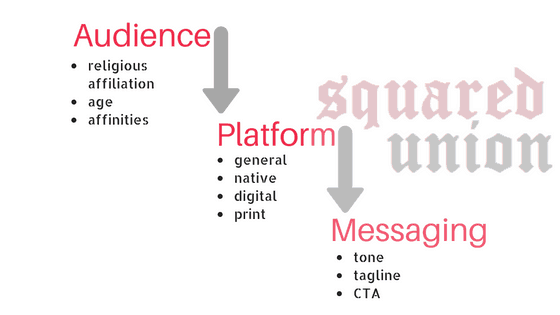
The advertising platforms used in a Jewish-centric marketing campaign play a central role in whether the effort is successful. Therefore, when choosing between platforms, it is vital to keep front and center the proverbial North Star as a guide in making this decision. Polaris, in this instance, is a combination of the identified Jewish audience deemed optimal and the nature of the offering. Specifically, the nuances of where and how this audience is most effectively reached and offering specifics will dictate which platforms to utilize.
If the audience primarily dictates platform choice, what helps to identify said audience? At its core, the nature of the product or service on offer will lead to uncovering the right target audience for the campaign. However, with that said, understanding the selling points of an offering, identifying the optimal audience, and finally, advertising platform utilization is indeed easier said than done.
Some of the most common challenges we encounter among prospective clients include confusion surrounding the various Jewish audiences and, more commonly, a lack of knowledge about which platforms will work best in their specific context. With an ever-expanding and highly dynamic advertising landscape, it is understandable that someone not regularly engaging in the Jewish marketing minutiae may feel overwhelmed. In this discussion, we review how we navigate platform decision-making and its interconnected relationship with offering and audience to provide clarity.
Offering
The analysis necessary for forming a successful Jewish marketing campaign begins with exploring the nuances of the offering, including its unique aspects and related advantageous characteristics. Whether marketing a product or service, delving into the nature of the offering and who it will most positively appeal to will form the foundation for a properly structured campaign. Gaining an appreciation for the classifications of an offering is so fundamental because the offering type dictates the optimal audience to pursue marketing activity.
There is no mystical recipe for achieving the requisite robust understanding of an offering. Sometimes the required knowledge is more common sense, and other times, perhaps based on an innate intuition. For example, for marketing an expensive travel experience at a five-star hotel, it is self-evident that one is working with a luxury offering and will, therefore, dictate a focus on an audience bracket with more disposable income. On the other hand, for a genetic test, is the right audience younger and those more interested in the novelty aspect, or perhaps those a bit older who need it out of necessity when seeking to start a family? Often, a single offering has various dimensions or appeals and will be relevant to more than one defined Jewish audience.
In the context of Jewish marketing, which contains many subtleties, a proper understanding of the offering often relies on an understanding of the broader Jewish audience. To gain a complete picture and explore all opportunities, viewing the offering in isolation is challenging in some scenarios. Instead, to get a full accounting of the marketing landscape and where efforts should be best concentrated, offering and audience need to be analyzed in lockstep.
Audience
It is possible to segment any group along various lines. Some differentiators can be drawn, whether it is a religion with different denominations, ethnicity with diverse communities, or a sport with varying weight classes. So too, with the broader Jewish population, there are endless ways to delineate differences within the wider general grouping. Some of these differences are more defined, such as ancestral background, while others are more transitory, like geographic location or current wealth strata. Even further along the spectrum are interest-based segments within the Jewish audience that cut across all divisions—tech-savvy or passionate about political matters. Importantly, in the marketing setting, many of these segmentation points are instrumental in formulating marketing.
Because the broader Jewish audience contains many of these different smaller groups, it is crucial to be able to navigate and try to reach the specific segments that are most relevant and optimal for the offering at hand. So often, a particular platform or targeting strategy will be most beneficial to reach one group, while another platform might be better for getting a different segment. For this reason, differentiating between variations in Jewish audiences is instrumental in platform choice.
For example, if a particular offering has been ascertained to have an optimal audience of Orthodox Jewish moms, utilizing a specific Jewish influencer might bring a better return on ad spend (ROAS) than an interest-based targeting campaign on Facebook. Like so much marketing, the only way to know for sure is based on testing and historical performance data. At the same time, educated decisions can be made based on the offer, audience, and platform knowledge.
Once the nature of the offering has been explored, and the optimal audience has been identified, the strategic choice of platform utilization can begin.
Platform
At the start, it is helpful to perform a precursory review of the current ad platform landscape. Platforms can be divided into two main categories at the most basic level. In one basket is analog advertising, and the other basket encompasses digital media. Analog is the old guard. Think print, out of home, and radio. Though there are advancements to make analog more tech-infused, the platforms remain lacking in two key areas. First, they do not include granular targeting capability; second, measurement of the advertising performance is limited. Digital platforms, such as Google and Facebook Ads, on the other hand, allow for precise targeting and measurement.
At first glance, based on this comparison, one may conclude that analog advertising is inferior and offers no value when contrasted with the more technologically advanced digital options. That would be a mistaken conclusion. Especially in a relatively specific market such as the Jewish one, analog platforms can offer excellent and unique value in particular settings. So much depends on the nature of the offering and the target customer profile. With that said, for many offerings, it should be the core focus because of the core advantages of digital relating to targeting and measurement.
The general preference for digital platforms is especially appropriate where the product or service is a “digital-first” offering. Such an offering relates to those where the touchpoint goal of the campaign is through the internet. The examples of such offerings are numerous but think purchases via websites, lead generation, or app downloads.
Beyond the most fundamental differences that separate analog and digital advertising, there are numerous sub-categories of platforms. Of note is that within the digital category, there are generalized platforms and others that we refer to as native platforms.
Generalized Platforms
When we think of generalized platforms, some of the most prominent players, such as Google and Facebook’s suite of ad products, come to mind. Such platforms can be utilized for various targeted marketing campaigns in the Jewish context or the mass market. With the comprehensive breadth of targeting options made available from these platforms, the potential to formulate a robust and lean marketing campaign is possible. For example, there is no sizeable minimum spend amount for testing campaigns. At the same time, with so many different options and settings at one’s disposal, it can become complicated and confusing as to what the “right recipe” for success is. From choosing good phrasing to geographical targeting as well as more ancillary aspects such as landing page design, in the aggregate, the abundance of choice can, for the inexperienced, have a detrimental impact on overall campaign performance.
Native Platforms
As of late, there has been an increasing emergence of new platforms that solely cater to those trying to reach the Jewish audience. Perhaps this is an ode to the growing awareness and popularity marketing to Jewish audiences has garnered over the last few years. These native platforms range in their scope, methodology, and performance. Some of them are pretty powerful when used strategically and correctly, while others, based on our experience, do not hold much potential. The primary challenge when it comes to these native platforms is discerning between those that do not provide significant potential from those that bring unique capabilities to the table.
A big concern when exploring smaller and more niche platforms revolves around transparency and accountability. As a general rule, we find that these platforms lack robust analytics and associated tracking capabilities. Further, measures to tackle ad fraud and other billing complexities are recurring issues. Much of the technology to create and maintain a robust ad-tech platform requires an enormous investment that the relatively small market for niche Jewish-focused platforms cannot support. In practically all scenarios, the reach offered by niche platforms can be replicated through the more robust media of Google and Facebook while at the same time not compromising on transparency and spending integrity. After all, the internet giants have a wealth of data that dwarfs niche ad products.
For these reasons, even when niche platforms hold potential value, we advise that they should only be used in specific contexts where generalized platforms are unlikely to perform better.
That said, the only surefire way to “pick and dispose of” platforms confidently is through hands-on experience using both generalized and native platforms and seeing the individual results they do or don’t bring.
It isn’t straightforward to provide direction in the abstract as to which platforms to use. What we can say is that using offering and audience to sift through platforms will help to provide clarity. Also, focusing on utilizing data, especially the massive amount of valuable targeting tools on offer from Google and Facebook, is a solid starting point for almost every product or service. Exploring inventive ways to reach your audience through these platforms can be intimidating, but experimentation, to some extent, is necessary. Further, knowing which campaigns to employ depending on the customer landscape is also an area to focus on. For example, Google Search Ads are great for in-market buyers actively searching for products and services. In contrast, display platforms are valuable for raising awareness of an offering and retargeting campaigns.
Ancillary to platform choice is the role that analytics and performance measurement play. It is especially essential to incorporate such tools because targeting via data-heavy platforms must continually be optimized based on past results. Whether it is conversion tracking or some other meaningful goal, knowing what is working and what may need improvement will help improve platform utilization and overall campaign performance progressively.
The Takeaway
A comprehensive approach to Jewish marketing helps ensure successful campaigns and proper platform utilization. Specifically, identifying an optimal Jewish audience is possible by first understanding the offering. Then, the right decisions regarding advertising platforms can be made using offering and audience in combination. Lastly, optimization of platform use through analytics will improve results.

